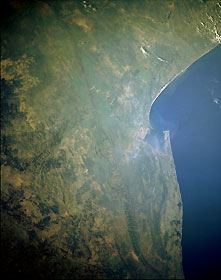
Save this image free of charge
in 800 pixels for layout use
(right click, Save as...)
|
|
Ref : T01526
Theme :
Looking at Earth - Sea - Coast - Capes - Peninsula (601 images)
Title : Southern Mozambique and Swaziland January 1993
Caption :
A striking topographic feature in this synoptic, low-oblique photograph is the prominent north-south-oriented Lebombo Mountains, whose elevations average approximately 2000 feet (610 meters). Known as the Lebombo monocline, its volcanic rocks are bounded by faults on the west side of the range, and it gradually dips eastward toward the Indian Ocean. Most of the fairly broad coast plain consists of low-lying, swampy terrain and many poorly drained lakes. Maputo, the capital city of Mozambique with a population of more than 2 million, is located on the west side of Maputo Bay, the large bay along the southern coast of Mozambique. The Pongola River, the major river that drains the coastal plains south of Maputo Bay, and a small sediment plume are visible south of the bay. Swaziland, one of southern Africa’s smallest independent countries, lies immediately west of the Lebombo Mountains, which form the boundary between eastern Swaziland and Mozambique. Farther west appear the northeast-southwest-trending Barberton Mountains of South Africa’s Transvaal. South Africa forms Swaziland’s north, west, and south boundaries. Because rainfall amounts increase toward the western, higher elevations of Swaziland, the high veld (large solid green area) in western Swaziland receives 45 to 75 inches (110 to 190 centimeters) of annual rainfall, thereby promoting a forest industry of mainly pines and eucalyptus trees.
|
|

